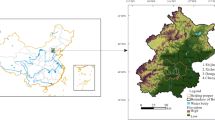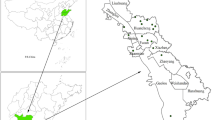Abstract
The main objective of this study is to evaluate the land-use change and its relationship with its driving factors in the loess hilly region. In this study, a case study was carried out in Pengyang County. We set two land-use demand scenarios (a baseline scenario (scenario 1) and a real land-use requirement scenario (scenario 2)) during year 2001–2005 via assuming the effect of driving factors on land-use change keeps stable from 1993 to 2005. Two simulated land-use patterns of 2005 are therefore achieved accordingly by use of the conversion of land use and its effects model at small regional extent. Kappa analyses are conducted to compare each simulated land-use pattern with the reality. Results show that (1) the associated kappa values were decreased from 0.83 in 1993–2000 to 0.27 (in scenario 1) and 0.23 (in scenario 2) in 2001–2005 and (2) forest and grassland were the land-use types with highest commission errors, which implies that conversion of both the land-use types mentioned above is the main determinant of change of kappa values. Our study indicates the land-use change was driven by the synthetic multiply factors including natural and social–economic factors (e.g., slope, aspect, elevation, distance to road, soil types, and population dense) in 1993–2000 until “Grain for Green Project” was implemented and has become the dominant factor in 2001–2005.
Similar content being viewed by others
References
Castella, J.-C., Pheng Kam, S., Dinh Quang, D., Verburg, P. H., & Thai Hoanh, C. (2007). Combining top-down and bottom-up modelling approaches of land use/cover change to support public policies: Application to sustainable management of natural resources in northern Vietnam. Land Use Policy, 24(3), 531–545. doi:10.1016/j.landusepol.2005.09.009.
Castella, J.-C., & Verburg, P. H. (2007). Combination of process-oriented and pattern-oriented models of land-use change in a mountain area of Vietnam. Ecological Modelling, 202(3–4), 410–420. doi:10.1016/j.ecolmodel.2006.11.011.
Chen, Y., Li, X., Su, W., & Li, Y. (2008). Simulating the optimal land-use pattern in the farming-pastoral transitional zone of Northern China. Computers, Environment and Urban Systems, 32(5), 407–414. doi: 10.1016/j.compenvurbsys.2008.01.001.
Congalton, R. G. (1991). A review of assessing the accuracy of classifications of remotely sensed data. Remote Sensing of Environment, 37, 35–46. doi:10.1016/0034-4257(91)90048-B.
Conway, G. R. (1985). Agroecosystem analysis. Agricultural Administration, 20, 31–55.
ESRI Inc. (2004). ArcGIS 9.1. Redlands, CA: ESRI.
Fu, B.-J., Hu, C. -X., Chen, L. -D., Honnay, O., & Gulinck, H. (2006). Evaluating change in agricultural landscape pattern between 1980 and 2000 in the loess hilly region of Ansai County, China. Agriculture Ecosystems & Environment, 114(2–4), 387–396. doi:10.1016/j.agee.2005.11.012.
ITT Visual Information Solutions (2004). ENVI V4.1. Boulder, CO: ITT Visual Information Solutions.
Landis, J., & Koch, G. (1977). The measurement of observer agreement for categorical data. Biometrics, 33, 159–174. doi:10.2307/2529310.
Paine, D. P., & Kiser, J. D. (2003). Chapter 23: Mapping accuracy assessment. New York: Wiley.
Pontius, R. G., & Schneider, L. C. (2001). Land-cover change model validation by an ROC method for the Ipswich watershed, Massachusetts, USA. Agriculture Ecosystems & Environment, 85(1–3), 239–248. doi:10.1016/S0167-8809(01)00187-6.
Rosenfield, G. H., & Fitzpatrick-Lins, K. (1986). A coefficient of agreement as a measure of thematic classification accuracy. Photogrammetric Engineering and Remote Sensing, 52(2), 223–227.
Serneels, S., & Lambin, E. F. (2001). Proximate causes of land-use change in Narok District, Kenya: A spatial statistical model. Agriculture Ecosystems & Environment, 85(1–3), 65–81. doi:10.1016/S0167-8809(01)00188–8.
SPSS Inc. (2004). SPSS V13.0. Chicago, IL: SPSS.
Verburg, P. H., Soepboer, W., Veldkamp, A., Limpiada, R., Espaldon, V., & Mastura, S. S. A. (2002). Modeling the spatial dynamics of regional land use: The CLUE-S model. Environmental Management, 30(3), 391–405. doi:10.1007/s00267-002-2630-x.
Verburg, P. H., Overmars, K. P., & Witte, N. (2004a). Accessibility and land-use patterns at the forest fringe in the northeastern part of the Philippines. The Geographical Journal, 170(3), 238–255. doi:10.1111/j.0016-7398.2004.00123.x.
Verburg, P. H., Ritsema van Eck, J., de Nijs, T. C. M., Dijst, J. M., & Schot, P. (2004b). Determinants of land-use change patterns in The Netherlands. Environment and Planning. B, Planning & Design, 31(1), 125–150. doi:10.1068/b307.
Verburg, P. H., Schot, P. P., Dijst, M. J., & Veldkamp, A. (2004c). Land use change modelling: Current practice and research priorities. GeoJournal, 61(4), 309–324. doi:10.1007/s10708-004-4946-y.
Zhang, H., Liu, L., Zhang, J., & Zhu, Z. (2007). A dynamic assessment of ecological security of land resources in loess hills region. Resources Science, 29(4), 193–200, In Chinese, with English abstract.
Author information
Authors and Affiliations
Corresponding author
Rights and permissions
About this article
Cite this article
Zhu, Z., Liu, L., Chen, Z. et al. Land-use change simulation and assessment of driving factors in the loess hilly region—a case study as Pengyang County. Environ Monit Assess 164, 133–142 (2010). https://doi.org/10.1007/s10661-009-0880-2
Received:
Accepted:
Published:
Issue Date:
DOI: https://doi.org/10.1007/s10661-009-0880-2




